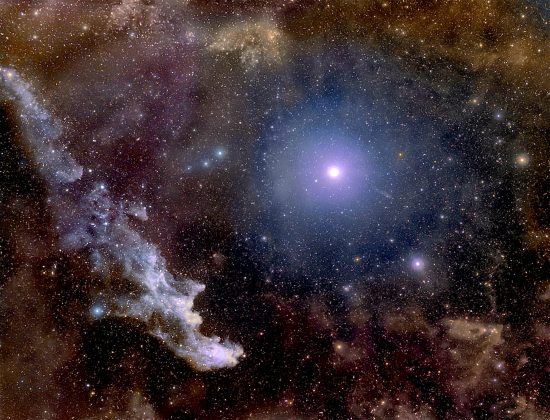
The blue-white supergiant star, Rigel in the constellation Orion and the Witch Head nebula. Credit: Rogelio Bernal Andreo/NASA.
Oct 31, 2018
Most astrophysical models about stars rely on mechanical action.
The collapse of cold gas under gravitational influence is thought to be the force that shapes stars. Common viewpoints see stars as collapsed whirlpools of gas and dust heated to fusion temperatures by pressure, alone. Gravity, it is said, draws wispy clouds into a region of increased density that, subsequently, coaxes even more material to collect there. Eventually, as conventional theories suggest, atoms within the cloud can no longer resist the inward attraction and they fall into nuclear fusion, initiating a self-sustaining reaction.
Astronomers believe that extremely massive blue-white stars live fast and die young. They “fuse” their hydrogen and helium into heavier elements that, in turn, fuse into elements that are heavier still. In their senescence, the radiative emissions from such stars are thought to be so intense that they “blow away” enormous quantities of stellar material. In some cases, they lose plasma up to a million times faster than the Sun. However, that process is highly speculative.
The Electric Star hypothesis resolves many of the distorted opinions that arise when astronomers misunderstand the role of plasma and electric fields in space. Rather than gravity and kinetic activity (heated gas), radiant emanations result from electric currents. More powerful electric flux results in more powerful energetic output. Electric discharges in plasma clouds create double layers, or sheaths, along their current axes. Positive charge builds up on one side and negative charge on the other. An electric field develops between the sides, and if enough current is applied, the sheath glows; otherwise it is invisible.
When electric charge flows along the sheaths, the currents spiral into filaments. The filaments attract each other, but rather than merging, they form zones of enormous compressive force known as z-pinches. Arc mode discharges might occur. Gravity, although it plays a small role in stellar evolution, is far too weak a force when compared to electric fields in plasma.
Since astronomers do not map the flow of electric charge through space, or consider its influence on stellar evolution, they overstate the case for gravitational models. The electrical input and output of the stars is not considered when theories are debated. By failing to give it credence, an entire line of investigation remains fallow.
Massive stars might not be so massive after all. The intense radiation that is interpreted as an “atmosphere blowing away” is most likely due to high input currents triggering frequent bursts of stellar lightning. What appears to be a hot, giant star might be a relatively small star with a large coma structure that is emitting a torrent of charged particles. Whether such stars live short or long lives has nothing to do with their gravitational mass, but with electric charge flow from the galaxy in which they reside.
Stephen Smith












